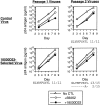Determinant of HIV-1 mutational escape from cytotoxic T lymphocytes
- PMID: 12743169
- PMCID: PMC2193781
- DOI: 10.1084/jem.20022138
Determinant of HIV-1 mutational escape from cytotoxic T lymphocytes
Abstract
CD8+ class I-restricted cytotoxic T lymphocytes (CTLs) usually incompletely suppress HIV-1 in vivo, and while analogous partial suppression induces antiretroviral drug-resistance mutations, epitope escape mutations are inconsistently observed. However, escape mutation depends on the net balance of selective pressure and mutational fitness costs, which are poorly understood and difficult to study in vivo. Here we used a controlled in vitro system to evaluate the ability of HIV-1 to escape from CTL clones, finding that virus replicating under selective pressure rapidly can develop phenotypic resistance associated with genotypic changes. Escape varied between clones recognizing the same Gag epitope or different Gag and RT epitopes, indicating the influence of the T cell receptor on pressure and fitness costs. Gag and RT escape mutations were monoclonal intra-epitope substitutions, indicating limitation by fitness constraints in structural proteins. In contrast, escape from Nef-specific CTL was more rapid and consistent, marked by a polyclonal mixture of epitope point mutations and upstream frameshifts. We conclude that incomplete viral suppression by CTL can result in rapid emergence of immune escape, but the likelihood is strongly determined by factors influencing the fitness costs of the particular epitope targeted and the ability of responding CTL to recognize specific epitope variants.
Figures







References
-
- Harrer, T., E. Harrer, S.A. Kalams, T. Elbeik, S.I. Staprans, M.B. Feinberg, Y. Cao, D.D. Ho, T. Yilma, A.M. Caliendo, et al. 1996. Strong cytotoxic T cell and weak neutralizing antibody responses in a subset of persons with stable nonprogressing HIV type 1 infection. AIDS Res. Hum. Retroviruses. 12:585–592. - PubMed
-
- Rinaldo, C., X.L. Huang, Z.F. Fan, M. Ding, L. Beltz, A. Logar, D. Panicali, G. Mazzara, J. Liebmann, M. Cottrill, et al. 1995. High levels of anti-human immunodeficiency virus type 1 (HIV-1) memory cytotoxic T-lymphocyte activity and low viral load are associated with lack of disease in HIV-1-infected long-term nonprogressors. J. Virol. 69:5838–5842. - PMC - PubMed
-
- Ogg, G.S., X. Jin, S. Bonhoeffer, P.R. Dunbar, M.A. Nowak, S. Monard, J.P. Segal, Y. Cao, S.L. Rowland-Jones, V. Cerundolo, et al. 1998. Quantitation of HIV-1-specific cytotoxic T lymphocytes and plasma load of viral RNA. Science. 279:2103–2106. - PubMed
Publication types
MeSH terms
Substances
Grants and funding
LinkOut - more resources
Full Text Sources
Other Literature Sources
Research Materials

